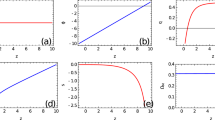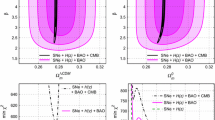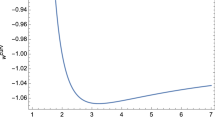Abstract
Using an approach that treats the Ricci scalar itself as a degree of freedom, we analyze the cosmological evolution within an \(f(R)\) model that has been proposed recently (exponential gravity) and that can be viable for explaining the accelerated expansion and other features of the Universe. This approach differs from the usual scalar–tensor method and, among other things, it spares us from dealing with unnecessary discussions about frames. It also leads to a simple system of equations which is particularly suited for a numerical analysis.
Access provided by Autonomous University of Puebla. Download conference paper PDF
Similar content being viewed by others
Keywords
These keywords were added by machine and not by the authors. This process is experimental and the keywords may be updated as the learning algorithm improves.
1 Introduction
Since the discovery of the accelerated expansion of the Universe from the observations of supernovae Ia [1–3] and its interpretation using the \(\varLambda \)CDM model of standard cosmology, a large amount of investigations have been devoted to explain the same phenomenon but using dark energy substances different from the cosmological constant \(\varLambda \). One can rank the dark energy models from the most “conservative” to the most “radical” ones. Among the former we can mention those which do not introduce new fields or modifications to general relativity but which consider that inhomogeneities in the Universe could be enough to account for the observations [4]. There are also the models that introduce new fields and perfect fluids with exotic equations of state within the framework of general relativity (GR) in order to avoid the “problems” associated with \(\varLambda \) [5–8]. For instance, quintessence, \(k\) -essence, and Chaplygin gas are some of the most popular models of this kind. The most radical attempts to explain the accelerated expansion are perhaps those which propose to modify GR while keeping the hypothesis of homogeneity and isotropy as a first approximation. Many alternate theories of gravity have been proposed to explain this phenomenon as well as those related with the dark matter (e.g. rotation curves of galaxies). The modified \(f(R)\) metric gravity is just one of such theories and maybe the most analyzed one in the last ten years, where the geometry takes care of mimicking the dark energy. This alternative is certainly radical since GR has been thoroughly tested for almost one hundred years and it has not only supported all the tests but in addition most of its predictions have been confirmed as well. Thus, the challenge of modified gravity is both to be consistent with GR tests and also to explain the phenomena they were called for. This is not a trivial task and many \(f(R)\) models have failed in the attempt. The story concerning dark substances does not end with the accelerated expansion. The measurements of the angular distribution of cosmic background radiation anisotropies in the sky can also be explained by the \(\varLambda \)CDM model, and therefore, the task for the alternative models, theories or dark energy substances is even more demanding.
As we mentioned, \(f(R)\) theories have been studied in detail in a recent past and it is out of the scope of the present article to discuss all the properties, problems and features associated with some of the specific models proposed before (see [9–13] for a review).
Our aim is to report the results of a potentially viable candidate, termed exponential gravity, as a model for the accelerated expansion, but using an approach that has been proposed recently by us [14] and which avoids the identification with the scalar–tensor theories. The reason to follow this “unorthodox” method is because in some cases the scalar–tensor (ST) method can lead to ill-defined potentials, and moreover because we want to circumvent any possible discussion concerning the use of frames (Einstein vs. Jordan). Debates of this sort plague the subject, some of which have only led to create confusion instead of shedding light.
With our technique we propose to treat the Ricci scalar itself as a degree of freedom, instead of using \(\phi =f_R\) as in the ST method (hereafter a subindex \(R\) indicates \(\partial /\partial _R\)). Our approach also spare us of inverting all the quantities depending on \(R\) for treating them as functions of \(\phi \). Moreover, we have found that in several specific applications the field equations can be recasted in a rather friendly way that allows us to treat them numerically or even analytically [14, 15]. In the next section we present our method and apply it to the Friedmann-Roberson-Walker (FRW) spacetime within the scope of analyzing the cosmological evolution using the exponential gravity model. The analysis of other viable \(f(R)\) models using the current approach can be seen in [14] and in references therein using other techniques.
2 \(f(R)\) Theories, the Ricci Scalar Approach
The action in \(f(R)\) gravity is given by:
where \(\kappa \equiv 8\pi G_0\) (we use units where \(c=1\)), \(f(R)\) is a sufficiently differentiable but otherwise a priori arbitrary function of the Ricci scalar \(R\), and \({\varvec{\psi }}\) represents schematically the matter fields. The field equation obtained from (1) is:
where \(f_R\) indicates \(\partial _R f\), \(\Box = g^{ab}\nabla _a\nabla _b\) is the covariant D’Alambertian and \(T_{ab}\) is the energy-momentum tensor (EMT) of matter associated with the \({\varvec{\psi }}\) fields. From this equation it is straightforward to obtain the following equation and its trace [14, 15]
where \((\nabla R)^2:= g^{ab}(\nabla _aR)(\nabla _b R)\) and \(T:= T^a_{\,\,a}\).
The idea is then to solve simultaneously (3) and (4) for the metric \(g_{ab}\) and \(R\) as a system of coupled partial differential equations.
It is important to mention that the field equations imply that the EMT of matter alone is conserved, i.e., it satisfies \(\nabla _a T^{ab}=0\).
In this contribution we shall focus on the model \(f(R)= R_*[{\tilde{R}} - \lambda (1- e^{-{\tilde{R}}})]\), referred to as exponential gravity, where \({\tilde{R}}= R/R_*\), \(\lambda \) is a positive dimensionless constant and \(R_*>0\) is also a constant that fixes the built-in scale and which is of the order of the current Hubble parameter \(H_0^2\). This kind of exponential models have been analyzed in the past by several authors using a different technique [16–21]. Other variants of this model have also been analyzed [22]. The scalar \(f_R= 1- \lambda e^{-{\tilde{R}}}\) is positive provided \(R> R_* \mathrm{ln} \lambda \) and this condition ensures \(G_\mathrm{eff}:= G_0/f_R>0\). This latter is always satisfied in the cosmological solutions given below. The possible de Sitter points correspond to trivial solutions \(R=R_1=const.\) of (4) in vacuum (\(T=0\)) and give rise to an effective cosmological constant \(\varLambda _\mathrm{eff}= R_1/4\) in (3) (\(G_{ab}= - g_{ab} \varLambda _\mathrm{eff}\) in vacuum). Here \(R_1>0\) is a critical point of the “potential” \(V(R)\) such that \(V_R(R_1)=0\) with \(V_R:=(2f-Rf_R)/3= R_*[{\tilde{R}}(1+\lambda e^{-{\tilde{R}}}) - 2\lambda (1- e^{-{\tilde{R}}})]/3\), and \(V_{{\textit{RR}}}= 1- \lambda (1+{\tilde{R}})e^{-{\tilde{R}}}\). The “potential” is given by \(V(R)= R_*^2[ {\tilde{R}}({\tilde{R}} - 4 \lambda ) - 2\lambda ({\tilde{R}} + 3) e^{-{\tilde{R}}}) ]/6\). For \(0<\lambda \le 1\) one can easily see that \(V(R)\) has just one critical point at \(R=0\) which is not a de Sitter point as in this case \(\varLambda _\mathrm{eff}\equiv 0\). The point is a global minimum (c.f. \(V_{{\textit{RR}}}(0)=1-\lambda \)). For \(\lambda > 1\) there is a local maximum at \(R=0\) and a global minimum at \(R=R_1>0\) which corresponds to the actual de Sitter point that the cosmological solution reaches asymptotically in the future. There is also a local minimum at \(R= R_2<0\), but it is an anti de Sitter point which is never reached as the cosmological solutions take place only in the domain \(R>0\). The potential \(V(R)\) is depicted in Fig. 1 (right panel) where one can appreciate the critical points just described. In the high curvature regime \({\tilde{R}}\gg 1\), we have \(f(R)\approx R- \lambda R_*\), and thus the model acquires an effective cosmological constant \(\varLambda _\mathrm{eff}^{\infty }:= \lambda R_*/2\) (c.f. left panel of Fig. 1). From the figure we see that for \(\lambda \) sufficiently high, the de Sitter point verifies \({\tilde{R}}_1\gg 1\), and thus \(R_1 \approx 2 \lambda R_*\) as it turns out from \(V_R(R_1)= 0\). Therefore \(\varLambda _\mathrm{eff}\approx \varLambda _\mathrm{eff}^{\infty }\). Finally, we stress that \(f_{{\textit{RR}}}= \lambda e^{-{\tilde{R}}}/R_* >0\) which ensures that no singularities are found in the equations due to this scalar and moreover it guarantees that given \(V_{{\textit{RR}}}(R_1)>0\) the effective mass \(m^2:= V_{{\textit{RR}}}/f_{RR}=(f_R-Rf_{{\textit{RR}}})/(3f_{RR})|_{R_1}\) of the scalar mode is positive.
3 Cosmology in \(f(R)\)
We assume the spatially flat FRW metric given by:
where a dot stands for \(d/dt\) and \(H= \dot{a}/a\), is the Hubble expansion. In the above equations we have included the energy density \(\rho \) associated with matter (baryons, dark matter and radiation) as well as the geometric dark energy (GDE) density \(\rho _{X}\) and pressure \(p_{X}\) given respectively by Jaime et al. [14]
Another differential equation that can be used to solve for \(H\) instead of (8) is given by \(R= 6(\dot{H} + 2 H^2)\). This latter is no other than the Ricci scalar computed directly from the metric (5). Equation (7) amounts to the modified Hamiltonian constraint which we use to set the initial data and also to monitor the accuracy of the numerical solutions at every integration step. At this regard, we stress that we shall not use the cosmic time \(t\) but instead \(\alpha = \mathrm{ln}(a/a_0)\) as “time” parameter (see [14]), where \(a_0\) is the present value of \(a\). Notice that at the de Sitter point \(R\rightarrow R_1=const.\) where \(2f(R_1)= R_1 f_R(R_1)\) and with \(\rho \rightarrow 0\), \(p_\mathrm{rad}\rightarrow 0\) (9) and (10), lead to \(\rho _X\rightarrow \varLambda _\mathrm{eff}/\kappa \) and \(p_X\rightarrow -\varLambda _\mathrm{eff}/\kappa \), respectively, and from (7) and (8), \(H^2\rightarrow H^2_\mathrm{vac}= \varLambda _\mathrm{eff}/3= R_1/12\), and \(q=-\ddot{a}/(aH^2)\rightarrow q_\mathrm{vac}= -1\). So the main idea behind all \(f(R)\) models is that as the Universe evolves, \(R\rightarrow R_1\), and thus the GDE dominates and mimics an effective cosmological constant that allows to explain the accelerated expansion required to account for the observations.
The matter variables obey the conservation equation \(\dot{\rho }_i= -3 H \left( \rho _i + p_i\right) \) for each fluid component (with \(p_\mathrm{bar,DM}=0\) and \(p_\mathrm{rad}= \rho _\mathrm{rad}/3\)) which integrates straightforwardly and gives rise to the usual expression for the energy density of matter plus radiation: \(\rho = (\rho _\mathrm{bar}^0 + \rho _\mathrm{DM}^0)(a/a_0)^{-3} + \rho _\mathrm{rad}^0 (a/a_0)^{-4}\), where the knotted quantities indicate their values today. The \(X\)–fluid variables (9) and (10) also satisfy a conservation equation similar to the one above, but with an EOS \(\omega _X:= p_X/\rho _X\) that evolves in cosmic time. Other possible inequivalent definitions of \(\rho _X\), \(p_X\) and \(\omega _X\) have been adopted in the past, but they suffer of several drawbacks (see [14] for a detailed discussion).
The total EOS is defined by \(\omega _\mathrm{tot} = (p_\mathrm{rad}+p_{X})/(\rho +\rho _{X})\) which using (9) and (10) yields
This EOS allows us to track the epochs where the Universe is expanding in a decelerating or accelerating fashion. If \(\omega _\mathrm{tot} < -1/3\) then \(\ddot{a} > 0\), while \(\ddot{a} < 0\) if \(\omega _\mathrm{tot} > -1/3\).
4 Numerical Results and Discussion
We integrate the differential equations forward, from past to future, starting from a given \(z= a_0/a -1\), where matter dominates, to \(z\rightarrow -1\) where the GDE prevails. The initial conditions are fixed as in [14]. Figure 2 shows the Hubble expansion and the Ricci scalar for several values of \(\lambda \). In all the cases where \(\lambda >1\), \(R\) reaches the de Sitter point at the global minimum of \(V(R)\). For \(\lambda =1\) because the potential is very flat around the global minimum at \(R=0\), and also due to the friction term, \(R\) varies very slowly as it approaches the minimum. This explains why in this case the model also mimics a cosmological constant. Figure 3 depicts the fraction of dimensionless densities \(\varOmega _i= \kappa \rho _i/(3H^2)\) which satisfy the constraint \(\varOmega _\mathrm{rad}\,+\,\varOmega _\mathrm{matt}\,+\,\varOmega _X =1\), where \(\varOmega _\mathrm{matt}:= \varOmega _\mathrm{bar}+ \varOmega _\mathrm{DM}\). The radiation contribution, although taken into account, is very small and cannot be appreciated from the plots. The current abundances at \(z=0\) (today) match reasonably well the predicted values of the \(\varLambda \)CDM model and the exponential models show an adequate matter domination era. The EOS of GDE is plotted in Fig. 4 (left panel), and like in other \(f(R)\) models [14], it oscillates around the phantom divide value \(\omega _\varLambda = -1\) before reaching its asymptotic value as \(z\rightarrow -1\). The total EOS depicted in Fig. 4 (right panel) shows that at higher \(z\) the Universe is dominated by matter with \(\omega _\mathrm{tot} \sim 0\), and then interpolates to the value \(\omega _\mathrm{tot}= -1\) in the far future. At \(z=0\), \(\omega _\mathrm{tot}\) is similar to the value \(\omega _\mathrm{tot}\sim 0.75\) predicted by the \(\varLambda \)CDM model. Figure 5 (left panel) shows the (modulus) luminous distance computed as in [14] and the deceleration parameter (right panel).
Evolution of \(\varOmega _\mathrm{matt}\) (red solid line) and \(\varOmega _X\) (blue solid line) for \(\lambda = 1\) and \(R_*= 4H_0^2\) (left panel) and \(\lambda = 2.5\) and \(R_*= 2H_0^2\) (right panel). For reference the corresponding quantities of the \(\varLambda \)CDM model are included in each panel (dashed lines)
Luminous distance (left panel) compared with the Union 2 data [3]. Deceleration parameter (right panel)
In these exponential models it is technically difficult to integrate far in the past since \(f_{{\textit{RR}}}\rightarrow 0\) exponentially. Since this quantity appears in the denominator of (6), it produces large variations that affects the precision during the numerical integration. This is something that we had encountered in other \(f(R)\) models [14].
The exponential model seems to be consistent with the cosmological observations and also with the Solar System [17]. Nevertheless, like other \(f(R)\) models that look viable as well, a closer examination is required in all possible scenarios before considering \(f(R)\) theories as a serious threat to general relativity.
References
Perlmutter, S., Aldering, G., Goldhaber, G., et al.: Measurements of omega and lambda from 42 high-redshift supernovae. Astrophys. J. 517, 565 (1999). doi:10.1086/307221
Riess, A., Filippenko, A., Challis, P., et al.: Observational evidence from supernovae for an accelerating universe and a cosmological constant. Astron. J. 116, 1009 (1998). doi:10.1086/300499
Amanullah, R.E.A.: Spectra and hubble space telescope light curves of six type Ia supernovae at \(0.511 < z > 1.12\) and the union2 compilation. Astrophys. J. 716, 712 (2010). doi:10.1088/0004-637X/716/1/712
Miscellaneous: Focus section on inhomogeneous cosmological models and averaging in cosmology. Class. Quantum Grav. 28(16), 42–53 (2011)
Sahni, V., Starobinsky, A.: The case for a positive cosmological \(\lambda \)-term. Int. J. Mod. Phys. D 9, 373 (2000). doi: 10.1142/S0218271800000542
Carroll, S.: The cosmological constant. Living Rev. Relativ. 4, lrr-2001-1 (2001). http://www.livingreviews.org/lrr-2001-1
Martin, J.: Everything you always wanted to know about the cosmological constant problem (but were afraid to ask). C. R. Physique 13, 566 (2012). doi:10.1016/j.crhy.2012.04.008
Bianchi, E., Rovelli, C.: Cosmology forum: is dark energy really a mystery? “No it isn’t”. Nature 466, 321 (2010). doi:10.1038/466321a
Nojiri, S., Odintsov, S.: Unified cosmic history in modified gravity: from \(F(R)\) theory to Lorentz non-invariant models. Phys. Rep. 505, 59 (2011). doi: 10.1016/j.physrep.2011.04.001
De Felice, A., Tsujikawa, S.: f(R) theories. Living Rev. Relativ. 13(3), lrr-2010-3 (2010). http://www.livingreviews.org/lrr-2010-3
Sotiriou, T., Faraoni, V.: \(f(R)\) theories of gravity. Rev. Mod. Phys. 82, 451 (2010). doi: 10.1103/RevModPhys. 82.451
Capozziello, S., de Laurentis, M.: Extended theories of gravity. Phys. Rep. 509, 167 (2011). doi:10.1016/j.physrep.2011.09.003
Clifton, T., Ferreira, P., Padilla, A., Skordis, C.: Modified gravity and cosmology. Phys. Rep. 513, 1 (2012). doi:10.1016/j.physrep.2012.01.001
Jaime, L., Patino, L., Salgado, M.: \(f(R)\) cosmology revisited. ArXiv e-prints arXiv:1206.1642 [gr-qc] (2012)
Jaime, L., Patiño, L., Salgado, M.: Robust approach to \(f(R)\) gravity. Phys. Rev. D 83, 024039 (2011). doi: 10.1103/PhysRevD.83.024039
Cognola, G., Elizalde, E., Nojiri, S., et al.: Class of viable modified \(f(R)\) gravities describing inflation and the onset of accelerated expansion. Phys. Rev. D 77, 046009 (2008). doi: 10.1103/PhysRevD.77.046009
Linder, E.: Exponential gravity. Phys. Rev. D 80, 123528 (2009). doi:10.1103/PhysRevD.80.123528
Yang, L., Lee, C.C., Luo, L.W., Geng, C.Q.: Observational constraints on exponential gravity. Phys. Rev. D 82, 103515 (2010). doi:10.1103/PhysRevD.82.103515
Bamba, K., Geng, C.Q., Lee, C.C.: Cosmological evolution in exponential gravity. J. Cosmol. Astropart. Phys. 2010(08), 021 (2010). doi:10.1088/1475-7516/2010/08/021
Elizalde, E., Nojiri, S., Odintsov, S., Sebastiani, L., Zerbini, S.: Nonsingular exponential gravity: a simple theory for early- and late-time accelerated expansion. Phys. Rev. D 83, 086006 (2011). doi:10.1103/PhysRevD.83.086006
Elizalde, E., Odintsov, S., Sebastiani, L., Zerbini, S.: Oscillations of the F(R) dark energy in the accelerating universe. Eur. Phys. J. C 72, 1843 (2012). doi:10.1140/epjc/s10052-011-1843-7
Zhang, P.: Testing gravity against the early time integrated Sachs-Wolfe effect. Phys. Rev. D 73, 123504 (2006). doi:10.1103/PhysRevD.73.123504
Acknowledgments
This work was partially supported by PAPIIT grants IN107113 and IN117012.
Author information
Authors and Affiliations
Corresponding author
Editor information
Editors and Affiliations
Rights and permissions
Copyright information
© 2014 Springer International Publishing Switzerland
About this paper
Cite this paper
Jaime, L., Salgado, M., Patiño, L. (2014). Cosmology in \(f(R)\) Exponential Gravity. In: Bičák, J., Ledvinka, T. (eds) Relativity and Gravitation. Springer Proceedings in Physics, vol 157. Springer, Cham. https://doi.org/10.1007/978-3-319-06761-2_51
Download citation
DOI: https://doi.org/10.1007/978-3-319-06761-2_51
Published:
Publisher Name: Springer, Cham
Print ISBN: 978-3-319-06760-5
Online ISBN: 978-3-319-06761-2
eBook Packages: Physics and AstronomyPhysics and Astronomy (R0)









